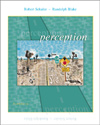| Braille | System of writing in which letters or characters are represented by patterns of tangible dots.
|
 |
 |
 |
| diffuse fibers | In touch system, first-order afferent neurons having large receptive fields with poorly defined borders.
|
 |
 |
 |
| diplesthesia | In touch, the illusory experience of two objects when only one is actually present.
|
 |
 |
 |
| free nerve endings | Nerve cells in the olfactory epithelium that mediate the common chemical sense.
|
 |
 |
 |
| haptics | Sensory information that depends upon both touch and kinesthesis.
|
 |
 |
 |
| kinesthesis | Information about the movement and position of a limb that derives from receptors that are in the muscles, tendons, and joints of that limb.
|
 |
 |
 |
| localization ability | An observer's capacity to identify the position of some stimulus.
|
 |
 |
 |
| mechanoreceptors | Receptors that respond to deformation of the skin.
|
 |
 |
 |
| Meissner corpuscles | An encapsulated touch receptor located in the skin's upper layer.
|
 |
 |
 |
| Merkel disk | An unencapsulated touch receptor located at an intermediate depth within the skin.
|
 |
 |
 |
| Pacinian corpuscle | An encapsulated touch receptor located in the skin's lower layer.
|
 |
 |
 |
| phantom limb | The illusory experience, often painful, that an amputated limb is still attached to the body.
|
 |
 |
 |
| proprioception | The sense that enables one to feel where one's limbs are.
|
 |
 |
 |
| punctate fibers | In touch system, first-order afferent neurons have small receptive fields with sharply defined borders.
|
 |
 |
 |
| rapidly adapting (RA) fibers | First-order afferent neurons that respond in a relatively transient manner to sustained deformation of the skin.
|
 |
 |
 |
| Ruffini endings | An unencapsulated touch receptor located at an intermediate depth within the skin.
|
 |
 |
 |
| slowly adapting (SA) fibers | First-order afferent neurons that respond in a relatively sustained manner to sustained deformation of the skin.
|
 |
 |
 |
| touch acuity | Ability to distinguish a small separation between two closely adjacent stimuli applied to the skin.
|
 |
 |
 |
| unilateral neglect | Neurological disorder in which a patient ignores events on one side of the body.
|



 2002 McGraw-Hill Higher Education
2002 McGraw-Hill Higher Education

 2002 McGraw-Hill Higher Education
2002 McGraw-Hill Higher Education